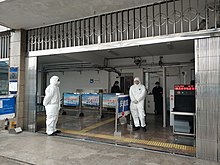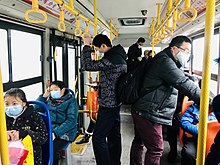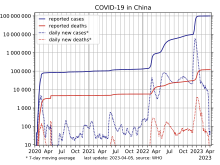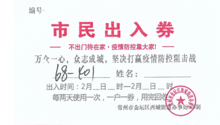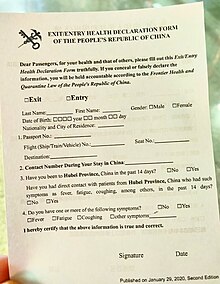COVID-19 pandemic in mainland China
The 2019–2020 COVID-19 outbreak in mainland China was the first wave of the disease, and was first manifested as a cluster of mysterious pneumonia cases, mostly related to the Huanan Seafood Market, in Wuhan, the capital of Hubei province.
[11] By late 2020, China's economy continued to broaden recovery from the recession during the pandemic, with stable job creation and record international trade growth, although retail consumption was still slower than predicted.
[14] Following nationwide protests in November and December of that year, the Chinese government relaxed many of its previous restrictions, effectively ending the zero-COVID policy and leading to a massive surge in cases.
[33][34] The typical symptoms of the viral infection included fever, dry cough, dyspnea, headache and pneumonia[35] which are usually developed after an incubation time lasting as long as 2 weeks.
A trade war with the US, the Hong Kong protests, and an African swine fever outbreak that led to a pork shortage already placed pressure on the current government.
[48][49] The outbreak went unnoticed until 26 December 2019, when Zhang Jixian, director of the Department of Respiratory Medicine at Hubei Xinhua Hospital, noticed a cluster of patients with pneumonia of unknown origin, several of whom had connections to the Huanan Seafood Market in Wuhan.
[54][55] Stringent measures such as lockdown of Wuhan and the wider Hubei province and face mask mandates were introduced around 23 January,[56] which significantly lowered and delayed the epidemic peak according to epidemiology modelling.
On 9 January, the cities of Shijiazhuang and Xingtai with total population of 19 million, were placed under lockdown measures, with passenger trains suspended, as well as flights and coach service to Beijing at 300 km distance in north east direction.
[122] On 11 January, the city of Zhengzhou has upgraded measures and closed down non-essential services during a citywide mass testing campaign[123] while Anyang has been placed under lockdown.
[162] A Caixin media report cited that Handan, Lu'an, Quanzhou, Suqian, Wuhu, Xining, Xuzhou along with many cities in Jilin, Shanxi, Heilongjiang, Jiangsu and Shaanxi was locked down in April, with more than 30 million people affected.
[164] On 3 May, the city of Zhengzhou imposed new movement restrictions, which halts all activities and only allows each household to one person with a negative test result to go out once a day to purchase basic supplies.
[168] On 31 May, Shanghai began to start lifting its strict lockdown measures, allowing people to return to work and malls and shops to re-open in "low-risk" areas.
[170] On 6 June, Beijing authorities further relaxed curbs by allowing indoor dining while the city of Erenhot and the Sonid Right Banner of Xilin Gol, Inner Mongolia have imposed lockdowns.
[200] In late October, dozens of cities across China have again ramped up their lockdowns, including districts of Shanghai, Guangzhou, Wuhan, Zhengzhou, Datong and Xining, affecting more than 200 million people.
[204] In Zhengzhou, workers at the Foxconn factory have turned to social media for help and to voice their anger about inadequate food and lack of medical care amid strict control measures implemented on the campus.
[205][206] On 2 November, the death of a 3-year-old boy to a gas leak in Lanzhou, reportedly after delay in receiving treatment due to movement restriction has triggered a wave of public anger.
[215] In Zhengzhou, protests erupted at the Foxconn iPhone manufacturing factory campus over poor pay and restriction conditions, after authorities attempted to lock down the facility following an outbreak.
This decision came as long lines of hearses appeared outside of crematoriums throughout China and medical students at universities nationwide protested for better pay and increased protections at overcrowded hospitals.
[232][233] On 22 December, a report by UK research firm Airfinity modelling based on regional Chinese data estimated that more than 5,000 people are probably dying each day from COVID-19 in China, with cases rising fastest in Beijing and Guangdong province.
[240] As China reopened in December 2022, an analysis of obituaries by the Times also found that retired Chinese scientists and scholars had begun to pass away at higher rates than would normally be expected, adding to speculation that deaths had been undercounted.
[244] In a 4 January media briefing, Director Tedros Ghebreyesus of the World Health Organization stated that Chinese hospitalization and mortality data lacked transparency and timeliness, while reiterating the importance of viral sequencing during the outbreak and continued vaccination efforts.
This percentage of infections meant that roughly 88.5 million people had contracted COVID-19 within just one month of the country's reopening, though Kan noted that visits to fever clinics in the province had peaked on 19 December.
[253] On 30 March, Chinese authorities announced a plan of random spot checks to be conducted at health facilities throughout the country in order to determine the future accuracy of local COVID data reporting amid global calls for more transparency during the winter surge.
[256] On 22 May, leading Chinese pulmonologist Zhong Nanshan contradicted earlier predictions and noted that the first major wave of infections following the reopening surge was beginning to build, with 65 million cases per week expected by the end of June.
E-commerce contributed substantially to China's COVID-19 pandemic response by facilitating fast delivery of personal protective equipment, food, and daily use consumer goods during lockdowns.
[261][262] In 2020 and 2021, although successive and lengthy lockdowns occasionally caused distress in border towns, the majority of publicly expressed commentary appeared to be largely in favor of China's stringent COVID mitigation strategies as necessary for the protection of human life, even to the point where complaints from locked-down residents sometimes resulted in online vitriol from compatriots outside of these regions.
[263] In 2022, however, with highly infectious Omicron strains impacting the feasibility of China's Zero-COVID policy, public discourse inside China became increasingly divided between citizens in favor of the stringent policies as a matter of both national pride and public health necessity, and people such as university students, migrant workers, and small business owners who felt that the restrictions on movement and livelihood were, in and of themselves, a cause of undue suffering.
In turn, upon the abrupt abandonment of Zero-COVID, some proponents of the discarded policy went on to criticize the government's sudden U-turn and question the need for a single, unified voice on such matters.
[264] Other commentators reacted with anger toward participants in the recent protests, blaming them for widespread infection and death, although data pointed to Omicron having already overwhelmed the mechanisms of Zero-COVID at the time of the policy's discontinuation.
[294][295] The Chinese government has worked to censor and counter reporting and criticism about the crisis – which included the prosecution of several citizen journalists[296] – and portray the official response to the outbreak in a positive light.
